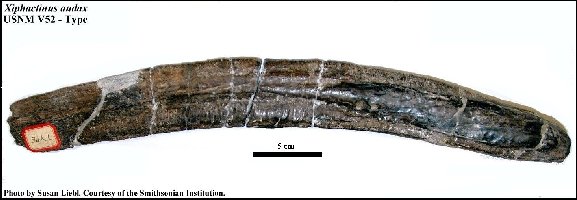| 12
PROCEEDINGS OF THE
ACADEMY OF "Descriptions of
Fossils collected during the U. S. Geol. Survey under the charge of Clarence King."
by F. B. Meek.
PROF. LEIDY exhibited specimens of ichthyodorulites,
upon which he made the following remarks:
XIPHACTINUS AUDAX.
The genus and species are founded on an interesting specimen belonging to the collection
of the Smithsonian Institution, and obtained from the cretaceous formation of Kansas by Dr. [George Miller] Sternberg. From the want of symmetry in the
base of the specimen, I suppose it to have been the pectoral spine of some huge siluroid
fish.
It is a broad sabre-shaped weapon, in its present
condition sixteen inches long, which is near its original length, if one may judge from
the thinness and rounding of the border at the broken end. At its middle it is nearly two
inches broad and almost seven and a half lines thick. It slightly narrows and becomes
thinner towards the outer end, and becomes thicker and more narrow approaching the base.
An inch and a half from the latter it is thirteen and a half lines thick and seventeen
lines wide; and the same distance from the outer end it is the fourth of an inch thick and
twenty lines wide. The anterior convex border is rounded at first, but becomes subacute at
its outer part. The posterior concave border is rather more obtuse.
A large groove commences back of the root, extending
outwardly, becoming contracted and deeper, and opening to its bottom along the under part
of the spine to its outer extremity. The bottom of the groove is irregularly pitted, and
its upper surface formed by the overhanging posterior portion of the spine is transversely
corrugated or striated. A similar but shallower groove commences in front of the root, and
extending outwardly opens beneath the spine at the anterior half of its surface.
The upper surface of the spine is nearly flat and longitudinally striated,
except at the outer part of the anterior border, where the striation is finer and curves
forward. The root of the spine turns up into a sort of hook-like process, broken at the
end. It has been about two and a half inches in height from a level with the inferior
surface of the spine. The inner part of the root forms a vertical oblong convexity, the
lower half of which is occurred by a raised facet, apparently an articular surface, upon
which the spine moved.
[Ed. note: Earl Manning (pers. comm. 12/2002) has
suggested that the following text in Prof. Leidy's remarks is probably the first
description of Protosphyraena perniciosa, even
though he erroneously associated the distinctive fin ray with the teeth of Ptychodus.
Click here to see a photograph of a similar fragment.]
Prof. Agassiz, in his Poissons Fossiles, has described
specimens of ichthyodorulites from the chalk of Lewes, England, "which he referred to
placoid fishes of the genus Ptychodus, "from the circumstance of their
constant occurrence in the same localities " as teeth upon "which the genus was
first established, These rays are especially remarkable for their segmented character,
"Instead of being composed of a single piece, as in other genera, they consist of
flat rods, or rather broad, thick plates intimately united but rendered distinct on the
surface of the ray by longitudinal grooves." Without question as to the reference of
these rays, I exhibit several similar specimens from the cretaceous formation of Kansas,
submitted to my examination by the Smithsonian Institution. The same collection of
fossils, of which the rays were part, also contained many teeth of Ptychodus mortoni,
but I am uninformed whether they were found in association.
The specimens are probably two fragments of the same
ray, but an intermediate piece is wanting, and they are imperfect at the opposite ends.
They also appear to be somewhat compressed from pressure. As a whole the ray is flat at
the sides, with a thickened, convex, posterior border, and an acute dentated or festooned
anterior border. The dentate processes are composed of a denser tissue than the rest of
the ray, and are thickened in a line from the point to the base, The body of the ray is
composed of longitudinally oblique bars ascending from the posterior border to the bases
of the dentate processes in which they are merged. The longer and broader fragment is four
and three-
[March
NATURAL SCIENCES OF PHILADELPHIA.
13
quarter inches long and three-quarters of an inch wide, gradually tapering to
seven lines, and is provided, with about seven and a half dentate processes. The other
fragment is three and three-quarter inches long, seven lines wide below, and four lines at
the broken apex; and is provided with nine dentate processes.
The segmented condition of the ray recalls to mind a
singular fossil specimen formerly described by me as the portion of a jaw of a fish to
which the name of Edestus vorax (Journ. Acad. Nat. Sci. iii, 159, p I. 15) was
given, and which also exhibits a segmented condition. This fossil, notwithstanding its
jaw-like appearance furnished with shark-like teeth, I have always suspected was an
ichthyodorulite (Proc. 1856, 301), and this suspicion is increased by an examination of
the rays supposed to pertain to Ptychodus.
(remainder of article removed)
...
1870] |


